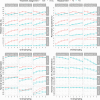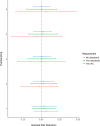Oversampling and replacement strategies in propensity score matching: a critical review focused on small sample size in clinical settings
- PMID: 34809559
- PMCID: PMC8609749
- DOI: 10.1186/s12874-021-01454-z
Oversampling and replacement strategies in propensity score matching: a critical review focused on small sample size in clinical settings
Abstract
Background: Propensity score matching is a statistical method that is often used to make inferences on the treatment effects in observational studies. In recent years, there has been widespread use of the technique in the cardiothoracic surgery literature to evaluate to potential benefits of new surgical therapies or procedures. However, the small sample size and the strong dependence of the treatment assignment on the baseline covariates that often characterize these studies make such an evaluation challenging from a statistical point of view. In such settings, the use of propensity score matching in combination with oversampling and replacement may provide a solution to these issues by increasing the initial sample size of the study and thus improving the statistical power that is needed to detect the effect of interest. In this study, we review the use of propensity score matching in combination with oversampling and replacement in small sample size settings.
Methods: We performed a series of Monte Carlo simulations to evaluate how the sample size, the proportion of treated, and the assignment mechanism affect the performances of the proposed approaches. We assessed the performances with overall balance, relative bias, root mean squared error and nominal coverage. Moreover, we illustrate the methods using a real case study from the cardiac surgery literature.
Results: Matching without replacement produced estimates with lower bias and better nominal coverage than matching with replacement when 1:1 matching was considered. In contrast to that, matching with replacement showed better balance, relative bias, and root mean squared error than matching without replacement for increasing levels of oversampling. The best nominal coverage was obtained by using the estimator that accounts for uncertainty in the matching procedure on sets of units obtained after matching with replacement.
Conclusions: The use of replacement provides the most reliable treatment effect estimates and that no more than 1 or 2 units from the control group should be matched to each treated observation. Moreover, the variance estimator that accounts for the uncertainty in the matching procedure should be used to estimate the treatment effect.
Keywords: Monte Carlo simulations; Oversampling; Propensity score matching; Replacement; Small samples.
© 2021. The Author(s).
Conflict of interest statement
The authors declare that they have no competing interests.
Figures




References
-
- Ensminger S, Fujita B, Bauer T, Möllmann H, Beckmann A, Bekeredjian R, et al. Rapid Deployment Versus Conventional Bioprosthetic Valve Replacement for Aortic Stenosis. J Am Coll Cardiol. 2018;71:1417–28. - PubMed
-
- Fraser CD, Zhou X, Palepu S, Lui C, Suarez-Pierre A, Crawford TC, et al. Tricuspid Valve Detachment in Ventricular Septal Defect Closure Does Not Impact Valve Function. Ann Thorac Surg. 2018. - PubMed
-
- Park D-W, Seung KB, Kim Y-H, Lee J-Y, Kim W-J, Kang S-J, et al. Long-Term Safety and Efficacy of Stenting Versus Coronary Artery Bypass Grafting for Unprotected Left Main Coronary Artery Disease: 5-Year Results From the MAIN-COMPARE (Revascularization for Unprotected Left Main Coronary Artery Stenosis: Comparison of Percutaneous Coronary Angioplasty Versus Surgical Revascularization) Registry. J Am College Cardiol. 2010;56:117–24. - PubMed
-
- Bejko J, Toto F, Gregori D, Gerosa G, Bottio T. Left ventricle assist devices and driveline’s infection incidence: a single-centre experience. J Artif Organs. 2018;21:52–60. - PubMed

